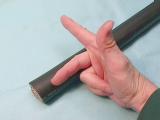


Experiments with motors
Generators
Electric generators are used to efficiently convert mechanical energy into electrical energy. Magnetism is the basis of their principles of operation. They use permanent magnets, electromagnets, and exploit the magnetic properties of materials in order to create these amazing machines.
The generators used to produce the voltages used in your home and in industry are large units, usually connected to a turbine which is powered by steam. The stand-by or emergency generators available for your home or camper are typically 4 to 10kW, and are powered by gasoline engines.
There are two basic types of generators:
DC generators
Used in older cars
Used in older machine
shops as a source for DC power for their DC motors
AC generators
Three-phase
Present day power generators
Used in today's cars, called alternators (they have diodes built in,
to convert the AC into DC for charging the battery)
Two-phase
Used
in the emergency home generators, provides two 120V circuits which
are combined to give a 240V circuit.
What happens when a wire moves with respect to a magnetic field?

This is the Right Hand Rule for generators.
The first finger points in the direction of the magnetic
field (first - field), which goes from the North pole to the South pole.
The thumb points in the direction of the motion of the wire
in the magnetic field (thumb - torque or thrust).
The second finger then points in the direction of the induced
current in the wire (second - current).
So, when a wire moves perpendicular to a magnetic field, cutting through the magnetic field lines, a voltage is induced across the wire. If the wire is part of a closed system, then current will flow. The faster the wire moves, the larger the amount of induced voltage and current. Please note that it does not matter whether the wire is moving or the magnetic field is moving, but that they move with respect to each other. If the wire moves parallel with the magnetic field, there will be no induced voltage or current.
This is what Faraday discovered.
Tethers in Space
If a long wire can be stretched between the space shuttle and a weight of some kind, so that it lies perpendicular to the surface of the earth, then the wire will be cutting through the earth's magnetic field lines, then a voltage will be induced in the wire. This is called an electrodynamic tether in space.
Now, if the ends of the wire can create a plasma to allow a current to flow along the wire, into the plasma, along the magnetic field lines of the earth to a lower level in the atmosphere, then back again to the other end of the wire (creating a closed system), then current will flow. How much? They expect about 2kV across a 10km tether, allowing about 10A to flow, thus achieving a 20kW generating system at 90% efficiency.
This is great! There is a proposed system which would use this tether for providing thrust or braking force, or providing power to the spacecraft. However, if it provides power to the spacecraft, it causes it to slow down (as you would expect since it is taking one form of energy and converting into another).
For further reading, please check these out:
https://en.wikipedia.org/wiki/Space_tether
http://www.tethers.com/papers/TethersInSpace.pdfhttp://www.drtulsian.com/interestingReading/physics/electromagnetic-tethers-in-space-qpdf.pdf
http://www.instructables.com/id/DIY-1000-watt-wind-turbine/